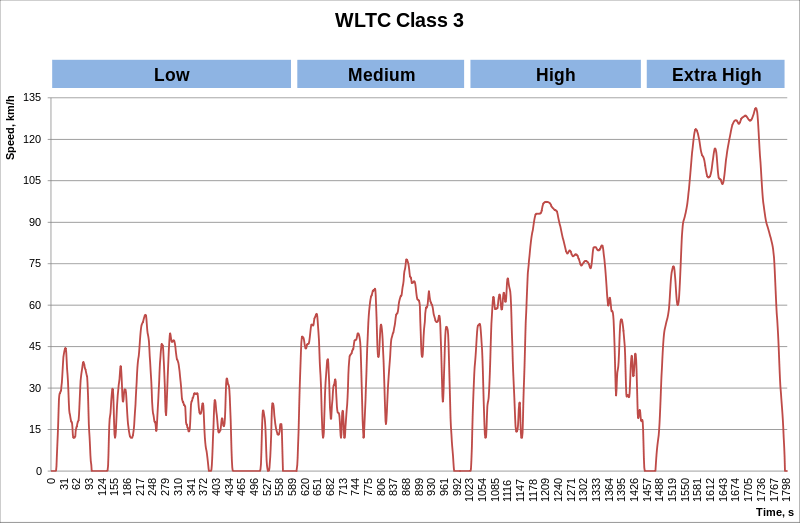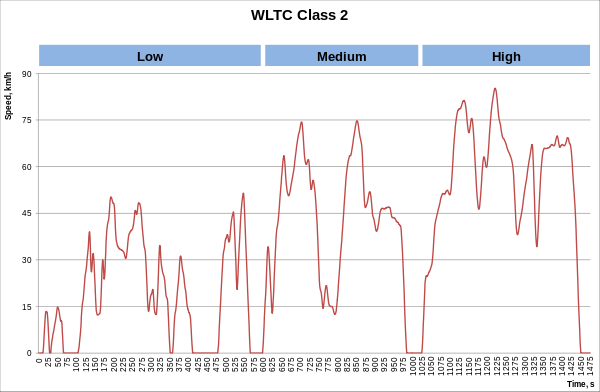Worldwide harmonized Light vehicles Test Procedures
| This article is part of a series on |
| Driving cycles |
|---|
| Europe |
| NEDC: ECE R15 (1970) / EUDC (1990) |
| United States |
| EPA Federal Test: FTP 72/75 (1978) / SFTP US06/SC03 (2008) |
| Japan |
| 10 mode / 10-15 Mode (1983) / JC08 (2008) |
| Global harmonized |
| WLTP (2015) |
The Worldwide harmonized Light vehicles Test Procedures (WLTP) define a global harmonized standard for determining the levels of pollutants and CO2 emissions, fuel or energy consumption, and electric range from light-duty vehicles (passenger cars and light commercial vans).
It is being developed by experts from the European Union, Japan, and India under guidelines of UNECE World Forum for Harmonization of Vehicle Regulations, with final version expected by October 2015.
Test procedure
The test procedure provides a strict guidance regarding conditions of dynamometer tests and road load (motion resistance), gear shifting, total car weight (by including optional equipment, cargo and passengers), fuel quality, ambient temperature, and tire selection and pressure.
Three different WLTC test cycles are applied, depending on vehicle class defined by power-weight ratio PWr in kW/Tonne (rated engine power / kerb weight):
- Class 1 - low power vehicles with PWr <= 22;
- Class 2 - vehicles with 22 < PWr <= 34;
- Class 3 - high-power vehicles with PWr > 34.
In each class, there are several driving tests designed to represent real world vehicle operation on urban and extra-urban roads, motorways, and freeways. The duration of each part is fixed between classes, however the acceleration and speed curves are shaped differently. The sequence of tests is further restricted by maximum vehicle speed Vmax.
Increased variety of manual gearboxes with 4, 5, 6 and 7 gears makes it impossible to specify fixed gear shift points. The WLTP testing procedure instead provides an algorithm for calculating optimal shift points, which takes into account total vehicle weight and full load power curves within normalized engine speeds, covering the wide range of rotation speeds and engine power allowed by current technology. To reflect practical use and fuel efficient driving style, frequent gear changes occurring in less than 5 seconds are filtered out.
WLTC driving cycles
Class 3
The WLTC driving cycle for a Class 3 vehicle is divided in four parts for Low, Medium, High, and Extra High speed; if Vmax < 135 km/h, the Extra High speed part is replaced with Low speed part.

| Low | Medium | High | Extra High | Total | |
|---|---|---|---|---|---|
| Duration, s | 589 | 433 | 455 | 323 | 1800 |
| Stop duration, s | 156 | 48 | 31 | 7 | 242 |
| Distance, m | 3095 | 4756 | 7158 | 8254 | 23262 |
| % of stops | 26.5% | 11.1% | 6.8% | 2.2% | 13.4% |
| Maximum speed, km/h | 56.5 | 76.6 | 97.4 | 131.3 | |
| Average speed without stops, km/h | 25.7 | 44.5 | 60.8 | 94.0 | 53.8 |
| Average speed with stops, km/h | 18.9 | 39.5 | 56.6 | 92.0 | 46.5 |
| Minimum acceleration, m/s2 | -1.5 | -1.5 | -1.5 | -1.2 | |
| Maximum acceleration, m/s2 | 1.5 | 1.6 | 1.6 | 1.0 |
Class 2
Class 2 test cycle has three parts for Low, Medium, and High speed; if Vmax < 90 km/h, the High speed part is replaced with Low speed part.

| Low | Medium | High | Total | |
|---|---|---|---|---|
| Duration, s | 589 | 433 | 455 | 1477 |
| Stop duration, s | 155 | 48 | 30 | 233 |
| Distance, m | 3132 | 4712 | 6820 | 14664 |
| % of stops | 26.3% | 11.1% | 6.6% | 15.8% |
| Maximum speed, km/h | 51.4 | 74.7 | 85.2 | |
| Average speed without stops, km/h | 26.0 | 44.1 | 57.8 | 42.4 |
| Average speed with stops, km/h | 19.1 | 39.2 | 54.0 | 35.7 |
| Minimum acceleration, m/s2 | -1.1 | -1.0 | -1.1 | |
| Maximum acceleration, m/s2 | 0.9 | 1.0 | 0.8 |
Class 1
Class 1 test cycle has Low and Medium speed parts, performed in a sequence Low-Medium-Low; if Vmax < 70 km/h, the Medium speed part is replaced with Low speed part.

| Low | Medium | Total | |
|---|---|---|---|
| Duration, s | 589 | 433 | 1022 |
| Stop duration, s | 155 | 48 | 203 |
| Distance, m | 3324 | 4767 | 8091 |
| % of stops | 26.3% | 11.1% | 19.9% |
| Maximum speed, km/h | 49.1 | 64.4 | |
| Average speed without stops, km/h | 27.6 | 44.6 | 35.6 |
| Average speed with stops, km/h | 20.3 | 39.6 | 28.5 |
| Minimum acceleration, m/s2 | -1.0 | -0.6 | |
| Maximum acceleration,m/s2 | 0.8 | 0.6 |